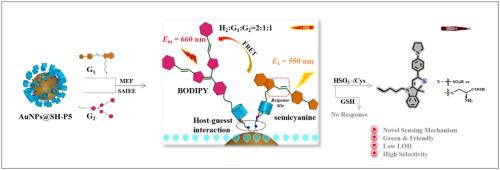基于半菁/BODIPY染料和金纳米粒子的高效能量转移人工捕光混合超分子纳米传感器用于检测HSO3−/Cys
IF 4.2
3区 工程技术
Q2 CHEMISTRY, APPLIED
引用次数: 0
摘要
人工光收集系统通过仿生设计构建,模拟自然光合作用的分步能量传递机制,可显著优化能量传递效率。在此,我们报道了一种基于半胱氨酸/BODIPY染料和金纳米粒子的高效能量转移人工光捕获混合超分子纳米传感器,用于检测HSO3−/半胱氨酸。首先,我们采用主-客体相互作用和分子共组装的策略,满足二亚胺功能化柱[5]芳烃(H1)、半花氨酸(G1)和BODIPY客体(G2)之间荧光共振能量转移的必要条件。实验结果表明,当少量G2掺杂时,二次FRET具有较高的能量传递效率和增强的天线效应。这种掺杂不仅提高了荧光量子产率,而且使这种超分子组装中的Stokes位移增加到195 nm。随后,将具有局部表面等离子体共振效应的AuNPs引入到超分子组件中,通过与柱[5]芳烯单元和G1的主客体相互作用,进一步降低毒性,提高灵敏度,并优化传感器的选择性。值得注意的是,由硫代柱[5]芳烃嵌入AuNPs (AuNPs@SH-P5)、G1和G2组成的杂化纳米探针通过金属增强荧光和超分子组装诱导的发射增强的协同作用,在纳mol范围内高效地检测出HSO3−/Cys,具有良好的选择性和较低的检测限。本文章由计算机程序翻译,如有差异,请以英文原文为准。

Efficient energy transfer artificial light-harvesting hybrid supramolecular nanosensor based on semicyanine/BODIPY dyes and gold nanoparticles for detection of HSO3−/Cys
The artificial light-harvesting system, constructed through biomimetic design that mimics the step-by-step energy-transfer mechanism of natural photosynthesis, can significantly optimize energy-transfer efficiency. Herein, we report an efficient energy-transfer artificial light-harvesting hybrid supramolecular nanosensor based on semicyanine/BODIPY dyes and gold nanoparticles for detection of HSO3−/cysteine. Firstly, we adopt the strategy of host-guest interaction and molecular co-assembly to meet the necessary conditions for fluorescence resonance energy transfer between naphthalene diimide-functionalized pillar[5]arene (H1), semicyanine (G1) and BODIPY guests (G2). The experimental results indicate that a secondary FRET occurs with high energy transfer efficiency and an enhanced antenna effect when a small amount of G2 is doped. This doping not only enhances the fluorescence quantum yield but also increases the Stokes shift to 195 nm in this type of supramolecular assembly. Subsequently, AuNPs exhibiting a localized surface plasmon resonance effect were introduced into supramolecular assemblies to further reduce toxicity, enhance sensitivity, and optimize selectivity of the sensor through host-guest interaction with the pillar[5]arene unit and G1. Notably, the hybrid nanoprobe consisting of thiolated pillar[5]arene-embedded AuNPs (AuNPs@SH-P5), G1, and G2 efficiently detected HSO3−/Cys with good selectivity and a low detection limit in the nanomolar range, through the synergistic effect of metal-enhanced fluorescence and supramolecular assembly-induced emission enhancement.
求助全文
通过发布文献求助,成功后即可免费获取论文全文。
去求助
来源期刊

Dyes and Pigments
工程技术-材料科学:纺织
CiteScore
8.20
自引率
13.30%
发文量
933
审稿时长
33 days
期刊介绍:
Dyes and Pigments covers the scientific and technical aspects of the chemistry and physics of dyes, pigments and their intermediates. Emphasis is placed on the properties of the colouring matters themselves rather than on their applications or the system in which they may be applied.
Thus the journal accepts research and review papers on the synthesis of dyes, pigments and intermediates, their physical or chemical properties, e.g. spectroscopic, surface, solution or solid state characteristics, the physical aspects of their preparation, e.g. precipitation, nucleation and growth, crystal formation, liquid crystalline characteristics, their photochemical, ecological or biological properties and the relationship between colour and chemical constitution. However, papers are considered which deal with the more fundamental aspects of colourant application and of the interactions of colourants with substrates or media.
The journal will interest a wide variety of workers in a range of disciplines whose work involves dyes, pigments and their intermediates, and provides a platform for investigators with common interests but diverse fields of activity such as cosmetics, reprographics, dye and pigment synthesis, medical research, polymers, etc.
 求助内容:
求助内容: 应助结果提醒方式:
应助结果提醒方式:


